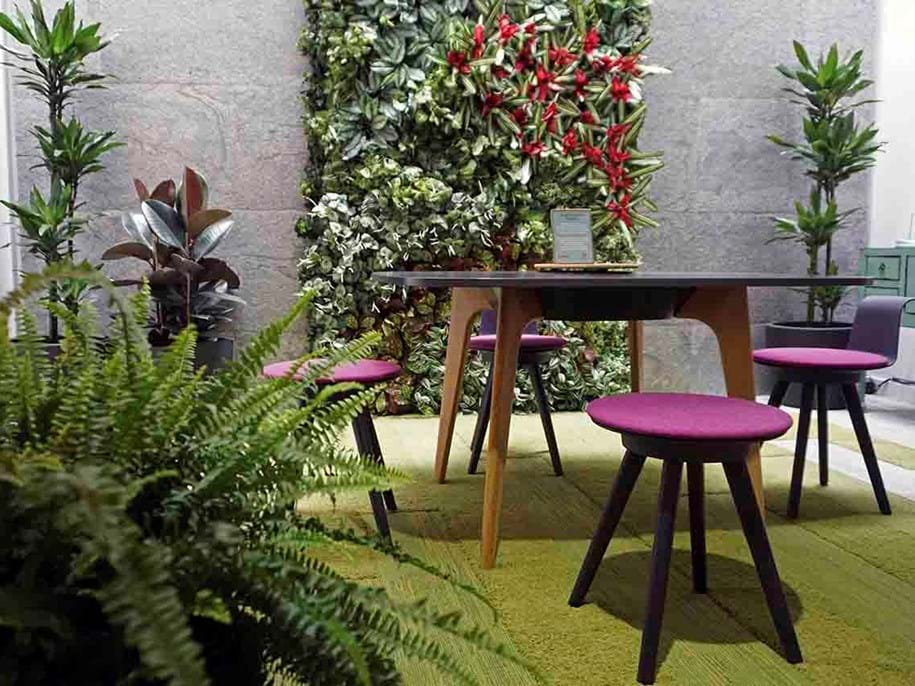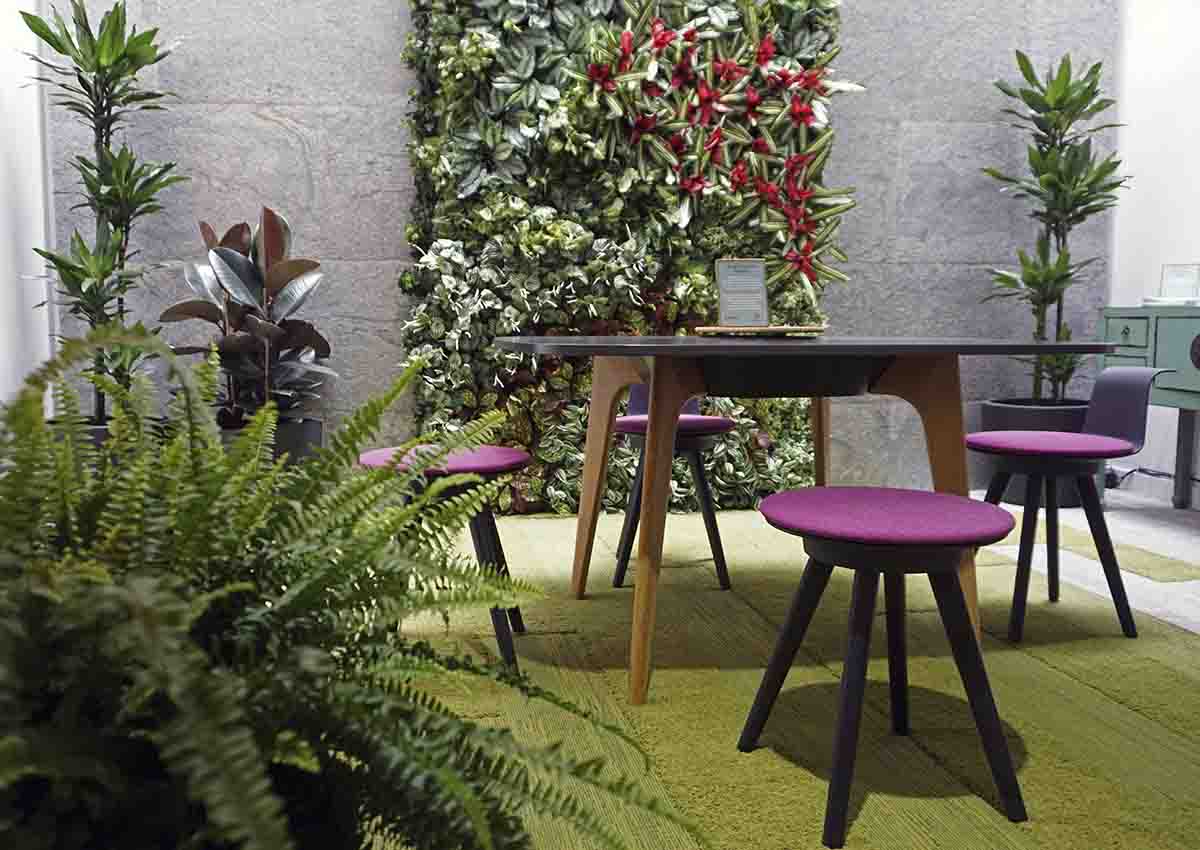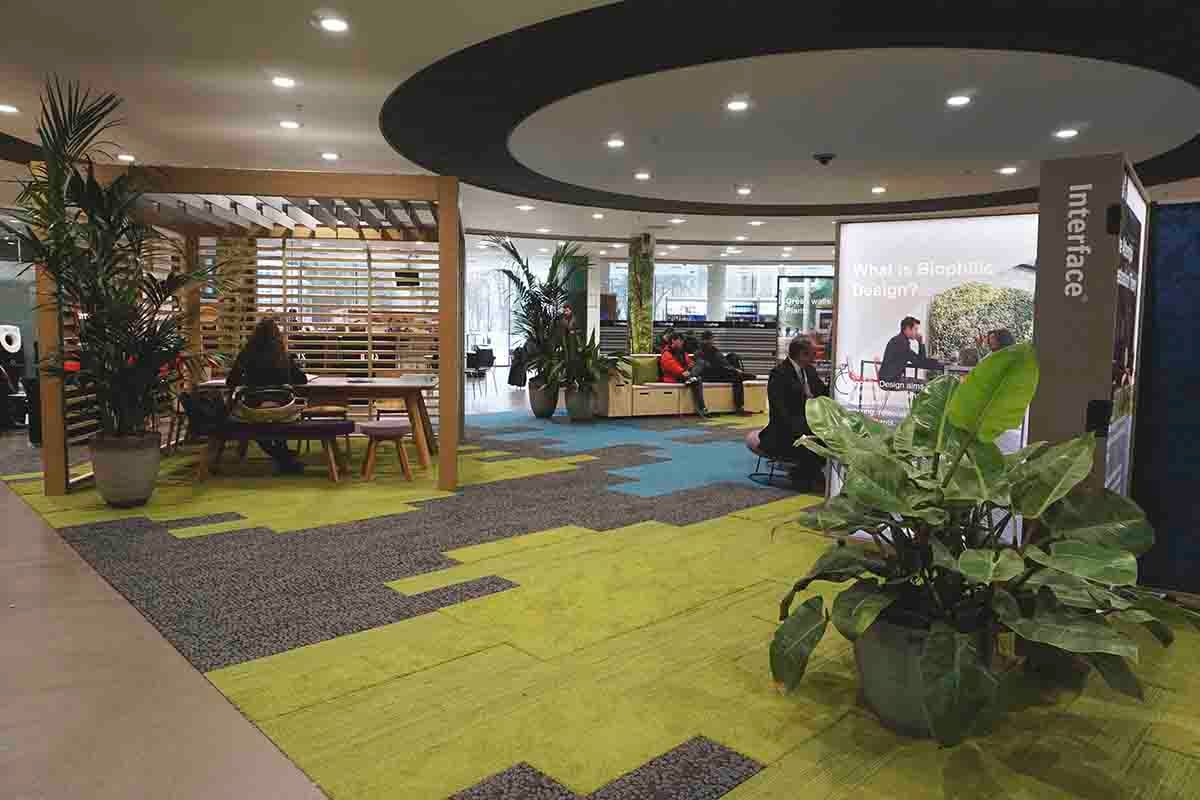
Biophilic design – how nature helps people and business to thrive
Activity-based design, human-centred design, biophilic design. There are several intertwined concepts and approaches to create enjoyable and productive workplaces. “I actually see biophilic design as an overarching umbrella, much more important than just a subsection of human-centred or activity-based design,” states architectural and biophilic designer Oliver Heath.
Biophilia means love of nature. It explains the human attraction to nature and the desire to be in and around it. The term was created by the German-American social psychologist Eric Fromm and popularised by Edward O Wilson, an American biologist, in the 1980s. According to the idea of biophilia, we have a genetic connection to the natural world after hundreds of thousands of years of living in and as part of nature.
Fromm and Wilson recognised people’s strong reaction to nature, and similarly how humans are detrimentally affected by staying in cities.

Architectural and biophilic designer Oliver Heath.
“These are places with a lot of stress and technology, but a lack of nature. The connection to nature has an ability to reduce stress and enhance our ability to recuperate. Essentially, biophilia is how and why we love being in and around nature,” says Oliver Heath.
The biophilia ideas were picked up by the American social ecologist Stephen Kellert. He created a framework of elements that you can bring into buildings to enhance that connection to nature, with three key areas:
1) Direct connection to nature
This is about having a direct connection to real forms of nature – plants, trees, water, fresh air, gentle motion, animals and even weather.
2) Indirect connection to nature
This is how we mimic and evoke a feeling of nature, using natural materials, colours, textures, patterns and different technologies.
3) Human spatial response (experience of space and place)
This is how we create spaces that are exciting, energising and stimulating, as well as spaces that are calming and relaxing. Aspects of this include the integration of parts into wholes, transitional spaces, mobility and wayfinding.
“We need all these features to create successful buildings. Biophilic design is about choosing different patterns within those three areas to help you deliver the intended functions in the workspace,” Oliver Heath explains.
Proven by many research studies
After living on the savannah, in the forest or by the sea for most of mankind’s history, we now find ourselves in urban, noisy and unhealthy spaces. The biophilic idea is to bring in nature as a means to reduce stress, aid recuperation and improve general mental and physical well-being. There are multiple benefits to creating these positive human states in many of the building typologies that are important to our lives. Oliver Heath says that these benefits have been proven by numerous research studies over the last 30 years, in all sorts of buildings.
“Pupils learn better in natural light, patients recuperate faster and with less medication when they can see nature, and there is evidence that it improves productivity, creativity and engagement in offices. Biophilic design is an evidence-based approach and one that far too few architects and designers know of or learn about when studying.”
He mentions hotels as an obvious example.
“If you go on holiday and book a hotel that has two sides, one overlooking the city and the other the beach – which is the most valuable? Well, it is quite obvious the beachside is the one most people prefer and will pay more for.”
Look at the long-term value
Of course, Oliver’s approach to biophilic design doesn’t always get everyone’s attention, initially at least. He meets quite a lot of resistance through the inability to properly value good design, too great a focus on short-term costs, and measuring a building’s success simply on the meeting of time frames and budgets.
 “Unless we undertake pre- and post-occupancy evaluations using both quantitative and qualitative research, how will we ever truly understand the value that our buildings and good design can have on us and the biggest cost element for businesses – their staff?”
“Unless we undertake pre- and post-occupancy evaluations using both quantitative and qualitative research, how will we ever truly understand the value that our buildings and good design can have on us and the biggest cost element for businesses – their staff?”
Oliver stresses the importance of taking a holistic approach when refurbishing or building offices.
"It is the long-term value you should be looking at. It is about attracting people, keeping them productive, happy and healthy, and making sure they don’t want to leave. In reality, 90 percent of the operating costs of a business are its staff. Every time a staff member leaves, as research suggests, it costs 2.5 times their salary to replace them.”
“For too long, we have taken an approach that design is about expressing the corporate identity, be that power, wealth, status or scale. But biophilic design has a much more intrinsic approach. It aims to help people to be in the best possible state to undertake the tasks requested of them – be that happy, calm, relaxed, creative, communicative or productive – to help them focus and to deliver on their tasks.”
Both physical and psychological effects
There are a lot of concepts and terms buzzing around the workplace business: activity-based design, biophilic design and human-centred design to pick a few. For a non-expert it seems that all these approaches are intertwined and focus on basically the same things.
 “It could be argued that biophilic design is a subsection of human-centred design. But I actually see biophilic design as an overarching umbrella, much more important than just being a subsection. With biophilic design, there are not only physical but also psychological benefits. If you walk into a building and see a profusion of plants and greenery, you’ll get an immediate visual sense: that if plants can survive here, maybe I can! And like the plants, I will thrive and flourish.”
“It could be argued that biophilic design is a subsection of human-centred design. But I actually see biophilic design as an overarching umbrella, much more important than just being a subsection. With biophilic design, there are not only physical but also psychological benefits. If you walk into a building and see a profusion of plants and greenery, you’ll get an immediate visual sense: that if plants can survive here, maybe I can! And like the plants, I will thrive and flourish.”
Bombarded with noise
Oliver talks a lot about evolution and how all our senses are connected to nature, not least our hearing. Through thousands of years we have used our ears to listen out for threats as well as opportunities. The snap of a twig in the forest means danger. The sound of running water means that a vital drink is within reach.
“Today, at work we are bombarded with noise: traffic, telephones, text messages, people tapping on keyboards or it might be a conversation nearby. In a big, open plan office, we can’t just expect that everyone can deal with that.”
That’s why getting the acoustics right is absolutely essential, stresses Oliver.
“Poor acoustics are enormously damaging in any type of building. But still it’s the one thing that so many designers tend not to think about until the project is completed.”
Add another layer of sound
Apart from getting the acoustics right and reducing the reverberation time, Oliver and his team are interested in how one can add another layer of sound, a layer that make us feel good.
“Having a positive acoustic layer on top can be very beneficial, particularly the sound of fresh, running water. It tends to mask the noise of speech, so it can actually help people to reduce distraction and so work better, with less physical and mental stress. But you have to double up on the senses – to make sure people can hear and also see the water. If you only hear water running, either it makes you think a pipe has burst or you feel an urge to go to the toilet. And that can be problem,” laughs Oliver Heath.
Toilet problems or not. With happier, healthier and more productive people as a net effect of biophilic design, isn’t it time we open our doors to nature?
Read more about biophilic design at oliverheath.com
Or listen to the episode about Biophilic acoustics at The Quiet Mark Podcast.
Text: Lars Wirtén
Photos: Oliver Heath Design
